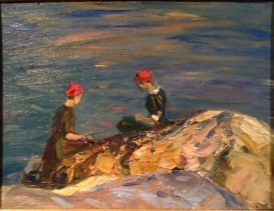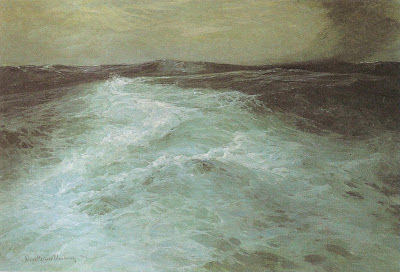 “The attempt to see in a large way is the point. Your studies are not of much importance, but you cannot overvalue the mental effort.”
“The attempt to see in a large way is the point. Your studies are not of much importance, but you cannot overvalue the mental effort.”
“Seeing big” is what Lynn-born painter Charles H. Woodbury drummed into the more than 4,000 students who flocked to his innovative “Art of Seeing” outdoor painting class for forty years straight during the first half of the 20th century.
Today, it’s a given that original artistic vision has as at least as much to do with great art as any technique. But teaching “how to see like an artist” was a radical idea in the early 1900s, when formal training in the use of paint was generally preceded by years of strictly ordered training in an Academy. The author of three once widely read (but now out-of-print) books on teaching, Woodbury exerted a far-reaching influence on art education in Boston, Maine, and Wellesley College, where he also conducted classes.
Woodbury established a summer painting school in 1898 in Ogunquit, Maine. It garnered national interest and inspired the formation of an art colony that drew the likes of Edward Hopper, George Bellows, and Robert Henri. Only with Woodbury’s death in 1940 did his “Art of Seeing” school close its doors, and even so the art association his former students established has remained active to this day.
So what ever happened to Woodbury? Though he had over 100 solo shows and his portrait was painted by his friend and art-world rock star John Singer Sargent, Woodbury isn’t nearly as widely known or discussed today as his more illustrious Modernist contemporaries. Part of the reason has to do with his respect for artistic tradition and his rejection of the innovations of Modernism in their more radical forms. Though he borrowed from Modernism and incorporated newly popularized visual-art principles from Asian art and the Art Nouveau, he proudly remained a relatively academic painter.
The MIT Museum mounted the first and only retrospective of Charles Woodbury’s oil paintings in 1988. MIT owns perhaps the largest collection of Woodburys anywhere because Charles graduated from the engineering school’s class of 1886. He later credited MIT watercolor instructor Ross Turner with the encouragement he needed to commit to an artistic career. By then, the 26-year-old was already an established Boston artist and was supporting himself by selling his paintings and teaching classes. He’d sold his first painting at 15 and in 1884, at the age of 17 became the youngest elected member of the Guild of Boston Artists, where his first solo show promptly sold out.
Picket Fences and Fishing Huts
Charles Herbert Woodbury was born in Lynn in 1864 to a well-established family of talented pragmatists. His earliest North American ancestor, a civil engineer, had laid out the town of Salem. His grandfathers and his father were prosperous businessmen and inventors of various mechanical devices that left the family moderately wealthy. At that time Lynn was an industrial city, the Woodburys’ Oxford Street home sported shady trees and a columned house with gardens and a picket fence, and Lynn Beach was a working shoreline where weathered fishing huts abutted ragged, marshy pasture.
It was there that Woodbury took a leading role in the formation of a group later known as the “Lynn Beach Painters.” Immediately after graduating from MIT, Woodbury took a studio at 22 School Street in Boston near fellow painter Charles Green, with whom he made a pact to make a living solely from painting. Woodbury, Green and five other young painters founded The Lynn Evening Drawing School in 1887. They claimed the title “regional impressionists” and made a name for themselves by painting, in a gritty, realist manner, the distinctly American scenery of the Saugus River, Swampscott, Lynn, Gloucester, and Revere.
One of Woodbury’s students, a talented young painter from Berwick, Maine named Susy Oakes, apparently so distracted Charles that he found himself unable to teach her to paint; in desperation he asked her to marry him instead. The shores and fields north of Boston were still pastoral but already industrializing, and when in 1888 Woodbury visited his fiancé in York, Maine, he must have seen the rocky, rural fishing villages as ideal subject matter. At his request, Susy changed her name to Marcia (her middle name) and Charles and Marcia Oakes Woodbury married in 1890 and sailed to Europe for an extended honeymoon.
In France, Charles dutifully studied for a few months at the famous Académie Julian in Paris. Though he was mostly self-taught, Woodbury always kept up his acquaintance with the important European artists of the day. That practical strain in the Woodbury genes meant his work won praise as honest, truthful, full of feeling, and admirably devoid of extravagance.
A large realistic painting he made in 1894 of the churning ocean viewed from the stern of a steamer made his name; the majestic “Mid-Ocean” was shown at the French Academy and toured the U.S., winning prizes and gaining him a reputation as perhaps the greatest marine painter in America after Winslow Homer. This masterpiece is owned by the Berkshire Athenaeum, Pittsfield’s public library, which purchased the work in either 1897 or ‘98. It’s currently on extended loan to the Berkshire Museum, also in Pittsfield, where it’s currently on display.

The entire conception of this work was something new. Most marine paintings included some land or some ships; Woodbury suspended the viewer midpoint over the waves, as if the viewer is being held out off the stern of the boat. He would use this compositional device many times over the course of his career. It allowed him to treat his theme in a more modern, abstract manner than his predecessors, who wouldn’t have thought of composing the canvas with a freedom inherited from Japanese woodblock design.
Even on that first trip to Europe, he took numerous photographs of the sea, not to paint from, but to study until he understood the physics of wave motion, foam distribution, and water swell. But it was the influence of French realism that allowed him to see past the romantic visions of the previous generation’s Hudson River marine painters. It was Realism, Barbizon, and Impressionism that told him it was alright to paint just what a passenger aboard a modern steamship could see simply by leaning at the rail.
And yet Woodbury was, at his best, a poet in paint as well; how else could one see to suggest the effervescent trace of human presence vanishing on the surface of the mighty forces of the ocean as they roll on into eternity?
“Paint in verbs, not in nouns.”
The shore and the sea in all its moods remained Woodbury’s primary subject for decades. Much of his work was done plein air, on location outside. With plein-air painting widely in vogue today, Woodbury’s ideas about seeing as an artist have never been more relevant.
In his notebooks, later published under the title Painting and the Personal Equation, Woodbury dissected his own process of seeing and painting and captured it in a teachable form. By the “personal equation” he meant the feelings and perceptions the artist brings to his work. “Paint it the way it seems,” he wrote, “not the way it looks.”
Even today, that’s a radical proposition for some painters. For Woodbury, painting was definitely not about making a photographic copy of the visible. He thought too analytically to leave it there, however, and questioned the role of subjectivity in art and the nature of perception itself.
“Realism is not based on the way things are, but upon things as you see and feel them,” he reasoned. “Realism is after all only what you think the thing may be.”
At the same time, Woodbury’s training as an engineer kept him mindful of what he called nature’s “conditions of force and resistance.” He saw and captured the world in motion: “Paint in verbs, not in nouns,” he wrote. “Don’t just paint a thing, paint it doing something.” Even when he painted rocks, he was thinking of magma, strata, pressure, and the tremendous forces that thrust the slabs above the surface of the earth that resisted them.
Paradoxically, he seems to have had a Buddhist-like sense of “no-mind,” of being present, in the now when he worked. He believed in “seeing big” and getting down “the great things first,” by which he meant in the first few minutes at the canvas. After that it was a matter of adding only the essential details and stopping before they began to detract from the initial record of the artist’s first impressions.
One of the advantages of such immediacy is that the quickly developed painting is immune to the outdoors’s ever-changing light. It amounts to a kind of recipe for keeping a painting fresh and loose, seemingly spontaneous, concerned as it is more with feelings and sensations than ideas or detailed rendering.
With such a modern slant, Woodbury’s approach translates well to contemporary plein-air practice. I took the occasion of a recent painting workshop I conducted to put Woodbury’s now-neglected methods to the test. We met in Perkins Cove, in view of Woodbury’s 1890’s studio, which has been lovingly restored and maintained in Ogunquit, ME. Reading his neglected books and reviving a lost philosophy of painting felt a bit like thawing a mammoth out of permafrost. But this beast had simply been in suspended animation. My students easily put Woodbury’s turn-of-the-century teachings into practice. I imagine they came out just as energized and amazed at their own capacity for “big seeing” and rendering their sensations as those who stood on the same ground a hundred years in the past.
For now, art history may be more or less indifferent to Woodbury’s work. But the philosophy of art he among others so earnestly helped to champion feels like it’s just coming fully into its own.
Images:
“Bathers by the Sea,” by Charles Woodbury. Collection of Sally Sulloway
“Mid-Ocean,” by Charles Woodbury, Collection of Berkshire Athenaeum


